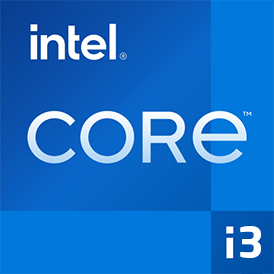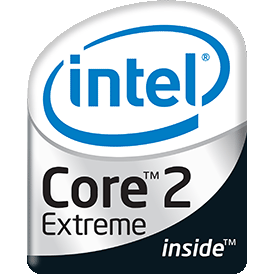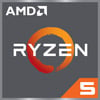
Intel Core i3-10105F vs Intel Core 2 Extreme QX6800
Ultimo aggiornamento:
Confronto con benchmark

|
 |

|
| Intel Core i3-10105F | Intel Core 2 Extreme QX6800 | |
Confronto CPUIntel Core i3-10105F o Intel Core 2 Extreme QX6800 - quale processore è più veloce? In questo confronto guardiamo le differenze e analizziamo quale di queste due CPU è migliore. Confrontiamo i dati tecnici e i risultati dei benchmark.
Il Intel Core i3-10105F ha 4 core con 8 thread e clock con una frequenza massima di 4,40 GHz. Fino a 128 GB di memoria sono supportati in 2 canali di memoria. Il Intel Core i3-10105F è stato rilasciato in Q1/2021. Il Intel Core 2 Extreme QX6800 ha 4 core con 4 thread e clock con una frequenza massima di 2,93 GHz. La CPU supporta fino a 16 GB di memoria in 2 canali di memoria. Il Intel Core 2 Extreme QX6800 è stato rilasciato in Q2/2007. |
||
| Intel Core i3 (205) | Famiglia | Intel Core2 Extreme (7) |
| Intel Core i 10000 (43) | Gruppo CPU | Intel Core 2 Extreme QX6000 (3) |
| 10 | Generazione | 1 |
| Comet Lake S | Architettura | Kentsfield (Core) |
| Desktop / Server | Segmento | Desktop / Server |
| -- | Predecessore | -- |
| -- | Successore | -- |
|
|
||
CPU Cores e frequenza di baseIl Intel Core i3-10105F è un 4 core processor con una frequenza di clock del 3,70 GHz (4,40 GHz). Intel Core 2 Extreme QX6800 ha 4 core CPU con una frequenza di clock di 2,93 GHz. |
||
| Intel Core i3-10105F | Caratteristica | Intel Core 2 Extreme QX6800 |
| 4 | Cores | 4 |
| 8 | Threads | 4 |
| normal | Architettura principale | normal |
| Si | Hyperthreading | No |
| No | Overclocking ? | Si |
| 3,70 GHz | Frequenza | 2,93 GHz |
| 4,40 GHz | Turbo Frequenza (1 Core ) | -- |
| 4,20 GHz | Turbo Frequenza (Tutti Cores) | -- |
Memoria & PCIeIntel Core i3-10105F supporta un massimo di 128 GB di memoria in 2 canali di memoria. Intel Core 2 Extreme QX6800 può connettersi fino a 16 GB di memoria in 2 canali di memoria. |
||
| Intel Core i3-10105F | Caratteristica | Intel Core 2 Extreme QX6800 |
| DDR4-2666 | Memoria | DDR3-1066, DDR2-800 |
| 128 GB | Max. Memoria | 16 GB |
| 2 (Dual Channel) | Canali di memoria | 2 (Dual Channel) |
| 42,7 GB/s | Max. Larghezza di banda | 17,1 GB/s |
| No | ECC | No |
| -- | L2 Cache | 8,00 MB |
| 6,00 MB | L3 Cache | -- |
| 3.0 | Versione PCIe | -- |
| 16 | Linee PCIe | -- |
| 15,8 GB/s | PCIe Larghezza di banda | -- |
Gestione termicaIl TDP (Thermal Design Power) di un processore specifica la soluzione di raffreddamento richiesta. Intel Core i3-10105F ha un TDP di 65 W, quello di Intel Core 2 Extreme QX6800 è 130 W. |
||
| Intel Core i3-10105F | Caratteristica | Intel Core 2 Extreme QX6800 |
| 65 W | TDP (PL1 / PBP) | 130 W |
| -- | TDP (PL2) | -- |
| -- | TDP up | -- |
| -- | TDP down | -- |
| 100 °C | Tjunction max. | -- |
Dettagli tecniciIntel Core i3-10105F ha una cache di 6,00 MB, mentre la cache Intel Core 2 Extreme QX6800 ha un totale di 8,00 MB. |
||
| Intel Core i3-10105F | Caratteristica | Intel Core 2 Extreme QX6800 |
| 14 nm | Tecnologia | 65 nm |
| Monolitico | Design a chip | Monolitico |
| x86-64 (64 bit) | Set di istruzioni (ISA) | x86-64 (64 bit) |
| SSE4.1, SSE4.2, AVX2 | Estensioni ISA | MMX, SSE2, SSE3 |
| LGA 1200 | Presa | LGA 775 |
| VT-x, VT-x EPT, VT-d | Virtualizzazione | VT-x |
| Si | AES-NI | No |
| Windows 10, Windows 11, Linux | Sistemi operativi | Windows 10, Linux |
| Q1/2021 | Data di lancio | Q2/2007 |
| 107 $ | Prezzo di rilascio | -- |
| mostra più dati | mostra più dati | |
Valuta questi processori
Performance media nei benchmark
⌀ Prestazioni single core in 1 benchmark CPU
⌀ Prestazioni multi-core in 2 benchmark CPU
Geekbench 5, 64bit (Single-Core)
Geekbench 5 è un benchmark multi-piattaforma che usa in modo intensivo la memoria del sistema.Il test single-core utilizza solo un nucleo elaborativo della CPU. A tal fine, il numero di nuclei elaborativi o la capacità di hyperthreading non sono rilevanti.
|
|
Intel Core i3-10105F
4C 8T @ 4,40 GHz |
||
|
|
Intel Core 2 Extreme QX6800
4C 4T @ 2,93 GHz |
||
Geekbench 5, 64bit (Multi-Core)
Geekbench 5 è un benchmark multi-piattaforma che usa in modo intensivo la memoria del sistema.Il test multi-core coinvolge tutti i nuclei elaborativi della CPU e si avvale del hyperthreading.
|
|
Intel Core i3-10105F
4C 8T @ 4,20 GHz |
||
|
|
Intel Core 2 Extreme QX6800
4C 4T @ 2,93 GHz |
||
Risultati stimati da PassMark CPU Mark
Alcune delle CPU elencate di seguito sono stati sottoposti a benchmarking da CPU-monkey. Tuttavia, la maggior parte delle CPU non sono state testate e i risultati sono stati stimati utilizzando una formula segreta di proprietà di CPU-monkey. Come tali, essi non riflettono con precisione i valori attuali di Passmark CPU Mark e non sono stati approvati da PAssMark Software Pty Ltd.
|
|
Intel Core i3-10105F
4C 8T @ 4,20 GHz |
||
|
|
Intel Core 2 Extreme QX6800
4C 4T @ 2,93 GHz |
||
Cinebench 2024 (Single-Core)
Il benchmark Cinebench 2024 si basa sul motore di rendering Redshift, utilizzato anche nel programma 3D di Maxon Cinema 4D. Le corse di benchmark durano 10 minuti ciascuna per testare se il processore è limitato dalla generazione di calore.
|
|
Intel Core i3-10105F
4C 8T @ 4,40 GHz |
||
|
|
Intel Core 2 Extreme QX6800
4C 4T @ 2,93 GHz |
||
Cinebench 2024 (Multi-Core)
Il test Multi-Core del benchmark Cinebench 2024 utilizza tutti i core della CPU per eseguire il rendering utilizzando il motore di rendering Redshift, utilizzato anche in Maxons Cinema 4D. L'esecuzione del benchmark dura 10 minuti per verificare se il processore è limitato dalla generazione di calore.
|
|
Intel Core i3-10105F
4C 8T @ 4,40 GHz |
||
|
|
Intel Core 2 Extreme QX6800
4C 4T @ 2,93 GHz |
||
Cinebench R23 (Single-Core)
Cinebench R23 è il successore di Cinebench R20 ed è anch'esso basato su Cinema 4D. Cinema 4D è un software usato a livello mondiale per creare forme in 3D. Il test single-core utilizza solo un nucleo elaborativo della CPU. A tal fine, il numero di nuclei elaborativi o la capacità di hyperthreading non sono rilevanti.
|
|
Intel Core i3-10105F
4C 8T @ 4,40 GHz |
||
|
|
Intel Core 2 Extreme QX6800
4C 4T @ 2,93 GHz |
||
Cinebench R23 (Multi-Core)
Cinebench R23 è il successore di Cinebench R20 ed è anch'esso basato su Cinema 4D. Cinema 4D è un software usato a livello mondiale per creare forme in 3D. Il test multi-core coinvolge tutti i nuclei elaborativi della CPU e si avvale del hyperthreading.
|
|
Intel Core i3-10105F
4C 8T @ 4,20 GHz |
||
|
|
Intel Core 2 Extreme QX6800
4C 4T @ 2,93 GHz |
||
Geekbench 6 (Single-Core)
Geekbench 6 è un punto di riferimento per computer, notebook e smartphone moderni. Ciò che è nuovo è un utilizzo ottimizzato delle architetture CPU più recenti, ad esempio basate sul concetto big.LITTLE e combinando core CPU di diverse dimensioni. Il benchmark single-core valuta solo le prestazioni del core della CPU più veloce, il numero di core della CPU in un processore è irrilevante qui.
|
|
Intel Core i3-10105F
4C 8T @ 4,40 GHz |
||
|
|
Intel Core 2 Extreme QX6800
4C 4T @ 2,93 GHz |
||
Geekbench 6 (Multi-Core)
Geekbench 6 è un punto di riferimento per computer, notebook e smartphone moderni. Ciò che è nuovo è un utilizzo ottimizzato delle architetture CPU più recenti, ad esempio basate sul concetto big.LITTLE e combinando core CPU di diverse dimensioni. Il benchmark multi-core valuta le prestazioni di tutti i core della CPU del processore. I miglioramenti del thread virtuale come AMD SMT o l'Hyper-Threading di Intel hanno un impatto positivo sul risultato del benchmark.
|
|
Intel Core i3-10105F
4C 8T @ 4,20 GHz |
||
|
|
Intel Core 2 Extreme QX6800
4C 4T @ 2,93 GHz |
||
Cinebench R20 (Single-Core)
Cinebench R20 è il successore di Cinebench R15 ed è anch'esso basato su Cinema 4D. Cinema 4D è un software usato a livello mondiale per creare forme in 3D. Il test single-core utilizza solo un nucleo elaborativo della CPU. A tal fine, il numero di nuclei elaborativi o la capacità di hyperthreading non sono rilevanti.
|
|
Intel Core i3-10105F
4C 8T @ 4,40 GHz |
||
|
|
Intel Core 2 Extreme QX6800
4C 4T @ 2,93 GHz |
||
Cinebench R20 (Multi-Core)
Cinebench R20 è il successore di Cinebench R15 ed è anch'esso basato su Cinema 4D. Cinema 4D è un software usato a livello mondiale per creare forme in 3D. Il test multi-core coinvolge tutti i nuclei elaborativi della CPU e si avvale del hyperthreading.
|
|
Intel Core i3-10105F
4C 8T @ 4,20 GHz |
||
|
|
Intel Core 2 Extreme QX6800
4C 4T @ 2,93 GHz |
||
Blender 2.81 (bmw27)
Blender è un software di grafica 3D gratuito per il rendering (creazione) di corpi 3D, che può anche essere strutturato e animato nel software. Il benchmark di Blender crea scene predefinite e misura i tempi richiesti per l'intera scena. Più breve è il tempo richiesto, meglio è. La scena di riferimento, abbiamo selezionato bmw27.
|
|
Intel Core i3-10105F
4C 8T @ 4,20 GHz |
||
|
|
Intel Core 2 Extreme QX6800
4C 4T @ 2,93 GHz |
||
CPU-Z Benchmark 17 (Single-Core)
Il benchmark CPU-Z misura le prestazioni di un processore misurando il tempo impiegato dal sistema per completare tutti i calcoli del benchmark. Più velocemente viene completato il benchmark, maggiore è il punteggio.
|
|
Intel Core i3-10105F
4C 8T @ 4,20 GHz |
||
|
|
Intel Core 2 Extreme QX6800
4C 4T @ 2,93 GHz |
||
CPU-Z Benchmark 17 (Multi-Core)
Il benchmark CPU-Z misura le prestazioni di un processore misurando il tempo impiegato dal sistema per completare tutti i calcoli del benchmark. Più velocemente viene completato il benchmark, maggiore è il punteggio.
|
|
Intel Core i3-10105F
4C 8T @ 3,70 GHz |
||
|
|
Intel Core 2 Extreme QX6800
4C 4T @ 2,93 GHz |
||
Cinebench R15 (Single-Core)
Cinebench R15 è il successore di Cinebench 11.5 ed è anch'esso basato su Cinema 4D. Cinema 4D è un software usato a livello mondiale per creare forme in 3D. Il test single-core utilizza solo un nucleo elaborativo della CPU. A tal fine, il numero di nuclei elaborativi o la capacità di hyperthreading non sono rilevanti.
|
|
Intel Core i3-10105F
4C 8T @ 4,40 GHz |
||
|
|
Intel Core 2 Extreme QX6800
4C 4T @ 2,93 GHz |
||
Cinebench R15 (Multi-Core)
Cinebench R15 è il successore di Cinebench 11.5 ed è anch'esso basato su Cinema 4D. Cinema 4D è un software usato a livello mondiale per creare forme in 3D. Il test multi-core coinvolge tutti i nuclei elaborativi della CPU e si avvale del hyperthreading.
|
|
Intel Core i3-10105F
4C 8T @ 4,20 GHz |
||
|
|
Intel Core 2 Extreme QX6800
4C 4T @ 2,93 GHz |
||
Dispositivi che utilizzano questo processore |
|
| Intel Core i3-10105F | Intel Core 2 Extreme QX6800 |
| Sconosciuto | Sconosciuto |
I confronti più popolari che contengono questa CPU
Torna all'indice









